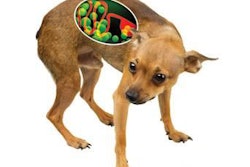The objectives of this study were to evaluate fecal calprotectin concentrations in healthy dogs and dogs with chronic diarrhea, to identify cutoff values for fecal calprotectin concentrations for use in differentiating dogs with chronic diarrhea and a canine chronic enteropathy clinical activity index (CCECAI) <12 from dogs with chronic diarrhea and a CCECAI ≥12, and to evaluate the association between histologic evidence of intestinal mucosal changes and fecal calprotectin concentrations in dogs with chronic diarrhea.
Fecal samples were taken from 96 adult dogs-27 dogs with chronic diarrhea and 69 healthy control dogs. Severity of clinical signs was evaluated on the basis of the CCECAI scoring system. An endoscopy was performed in all dogs with chronic diarrhea, and mucosal biopsy specimens were evaluated histologically. Fecal calprotectin concentration was quantified via radioimmunoassay. Fecal calprotectin concentrations were significantly higher in dogs with chronic diarrhea than in healthy control dogs. Fecal calprotectin concentrations were also significantly higher in dogs with a CCECAI ≥12, compared with concentrations for dogs with a CCECAI between 4 and 11. Fecal calprotectin concentrations were significantly higher in dogs with chronic diarrhea associated with histologic lesions, compared with concentrations in control dogs, and were significantly correlated with the severity of histologic intestinal lesions.
In conclusion, fecal calprotectin may be a useful biomarker in dogs with chronic diarrhea, especially dogs with histologic lesions.
Source: Aurélien Grellet et al., 2013. Fecal calprotectin concentrations in adult dogs with chronic diarrhea. AJVR online, May 2013. doi: 10.2460/ajvr.74.5.706
















